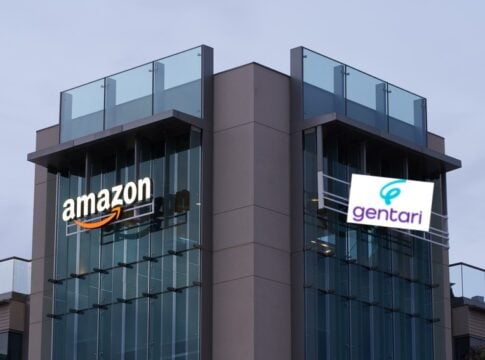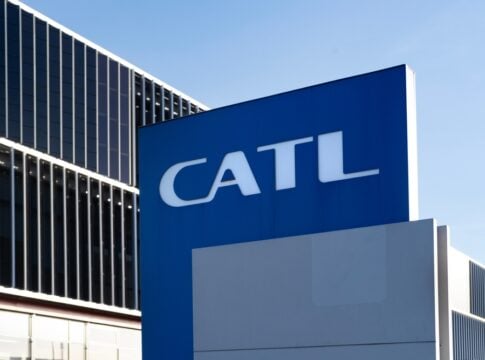Avoiding a climate catastrophe and reducing carbon emissions poses significant technical and societal challenges. Transitioning power and transportation systems, in particular, to rely on renewable energy sources will necessitate a considerable increase in copper use, far beyond what current production levels can accommodate.
But the critical question remains: Is the traditionally cautious mining industry committed to producing more copper to meet the world’s rewiring needs?
Copper’s Crucial Role in the Energy Transition
Copper plays a pivotal role in the energy transition due to its exceptional conductivity, second only to silver. While more cost-effective alternatives like aluminum exist, they come with efficiency compromises.
Copper is found in a diverse array of products, from toasters and air conditioners to microchips. The average car contains around 65 pounds (29 kilograms) of copper, and the typical home boasts over 400 pounds.
The construction of more complex grids capable of managing electricity generated by decentralized renewable sources and stabilizing their intermittent supply requires millions of feet of copper wiring. Solar and wind farms, often covering expansive areas, demand more copper per unit of power generated than centralized coal- and gas-fired power stations.
Electric vehicles (EVs) use over twice as much copper as traditional gasoline-powered cars, as per the Copper Alliance.

This electric metal is ideal for making various decarbonizing technologies. Taken together, these clean energy technologies can potentially abate around 2/3 of global GHG emissions by 2050.
Meeting net zero carbon emission targets by 2035 would likely require doubling annual copper demand to 50 million metric tons, as estimated by an industry-backed study by S&P Global.
Even more conservative projections foresee a one-third increase in demand over the next decade, driven by increased investments in decarbonization by governments and businesses. It could grow to almost double by 2035, however, the availability of such significant quantities of copper remains uncertain.
While there is an increase in copper recycling, it’s unlikely to meet the rising demand, leaving mining as the primary source. Although there’s an ample supply underground, boosting output significantly faces several challenges.
Copper’s fluctuations mirror those of the global economy, rising and falling with industrial production. This makes miners cautious about expanding capacity, fearing a downturn in demand.
Additionally, there’s a fundamental challenge: extracting copper from new deposits is becoming more difficult and costly as ore grades decline, requiring more mining to yield the same amount of metal. Heightened scrutiny of the environmental impacts of copper mining further dampens investment enthusiasm.
Supply Crunch Looms as Demand Soars

A recent copper price rally has sparked speculation among traders and executives about a potential supply crunch. Goldman Sachs Group Inc. estimates that addressing an expected annual supply shortfall of 8 million tons over the next decade would require the industry to invest $150 billion.
However, reaching this level of investment would necessitate copper prices reaching record highs, as noted by Trafigura Group and BlackRock Inc.
Just as oil shaped geopolitics in the last century, access to copper is becoming a crucial economic concern in the present one, prompting governments to vie for limited future supplies. The majority of copper ore is mined in Latin America and Africa, processed locally into a more concentrated form, and then exported to other nations for smelting into pure copper.
China, lacking sufficient domestic reserves, has compensated by acquiring mines abroad and expanding its smelting capacity domestically. While China’s surplus capacity has driven smelting fees to historic lows, the US and its allies are uneasy about Beijing’s influence over such a critical industry.
Consequently, they seek to increase sourcing and refining of essential metals for the energy transition domestically or in friendly nations.
Trends Shaping Copper’s Demand and Future Market
In the event of severe copper shortages, prices would soar, potentially jeopardizing the economics of EVs, smart grids, and renewable energy, thereby impeding their adoption. Clean energy technology manufacturers could mitigate this risk by finding ways to reduce copper use in their products.
Higher prices would incentivize miners to increase production, but developing a new mine takes several years. Even if a surge in demand prompted miners to invest heavily in new projects, it would take about a decade to significantly impact output projections.
The post Copper and the Need to Meet the World’s Rewiring Demand for Energy Transition appeared first on Carbon Credits.
Carbon Footprint
Fortescue and China’s $2B Green Deal: Can the Australian Iron Ore Giant Go Fossil-Free?
Fortescue, one of the world’s largest iron ore producers and a leading player in green energy, has secured a $2 billion loan from Chinese banks to accelerate its decarbonization plans. The funding is part of the company’s broader goal to achieve net-zero emissions by 2030 for its Scope 1 and Scope 2 operations.
The loan marks one of the largest green financing deals between an Australian mining company and China. It comes when demand for low-carbon industrial production is rising. This growth is due to global climate goals and investor pressure for cleaner operations.
Fortescue will use the funds for several key projects, particularly renewable energy projects. They will replace diesel-powered equipment with electric options. Also, they will invest in green hydrogen production.
Where Will Fortescue Spend the $2 Billion?
Mining is one of the most carbon-intensive industries. Fortescue operates in the Pilbara region of Western Australia. Right now, they rely mostly on fossil fuels, especially diesel. This fuels their mining trucks, trains, and power generation.
However, the company plans to stop using fossil fuels by 2030. This bold goal needs a lot of investment.
The $2 billion loan will fund infrastructure upgrades. This includes renewable energy projects, electric transport fleets, and hydrogen systems. According to Fortescue, these measures could cut millions of tons of carbon dioxide equivalent (CO₂e) from its annual emissions.
Andrew Forrest AO remarked:
“This isn’t just a financial transaction. It’s a signal of what is possible when partners are aligned in ambition. As the United States steps back from investing in what will be the world’s greatest industry, China and Fortescue are advancing the green technology needed to lead the global green industrial revolution.”
China’s Role in the Green Mining Shift
China is Australia’s largest iron ore customer and also a rapidly expanding player in green finance. By working with Chinese banks, Fortescue strengthens both its financial position and its long-term commercial relationships.
For China, supporting Fortescue’s decarbonization aligns with its own push for greener supply chains. The world’s largest emitter is working towards its 2060 carbon neutrality goal. It is urging major suppliers to cut emissions, particularly in resource-heavy sectors.
This financing could open doors for Chinese investment in Fortescue’s green hydrogen projects. These projects aim to export clean energy to global markets, like China.
- SEE MORE: China’s First-Ever Sovereign Green Bond Hits Global Market: Will It Power Its Net Zero Ambitions?
From Ore to Zero: Fortescue’s Bold 2030 Pledge
In 2024, Fortescue reported the following GHG emissions profile:
- Scope 1 and 2 Emissions: 2.72 million tonnes CO2e (combined direct and purchased energy emissions for Fortescue’s operations).
- Scope 3 Emissions: 269.31 million tonnes CO2e, roughly 100 times greater than Scope 1 and 2 combined.
- Majority Source of Scope 3: The steelmaking process downstream accounts for about 97% of Scope 3 emissions (262.16 million tonnes CO2e).
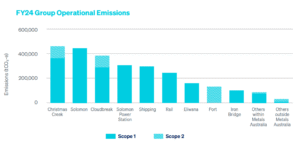
This rise in emissions compared to the previous year (2.55 million tonnes CO₂e) can be due to operational scale and fuel consumption changes.
Scope 3 emissions, mainly from steelmaking customers, stayed high at over 260 million tonnes CO₂-e. This highlights the challenge of lowering emissions throughout the value chain.

In 2024, Fortescue reported that it had already begun trials of electric mining haul trucks and hydrogen-fueled locomotives. The $2 billion loan will help scale these trials into full commercial deployment.
Fortescue aims to stop burning fossil fuels across its Australian iron ore operations by 2030. This “Real Zero” goal targets the absolute elimination of Scope 1 and Scope 2 emissions for its terrestrial iron ore business.
Fortescue’s Four Pillars of a Mining Makeover
The company is moving on four clear fronts:
- electrifying heavy equipment,
- building large renewable power,
- producing green hydrogen, and
- adding energy storage.
Fortescue plans to buy hundreds of electric machines. These machines will replace much of its diesel fleet and cut fuel use at scale.
On the power side, Fortescue is building utility-scale solar to run mines and support green hydrogen. It started work on a 190 MW solar farm near Cloudbreak. It is also seeking approval for a 644 MW solar hub at Turner River.
Together, these projects will add hundreds of megawatts of renewable energy to Pilbara operations. Large solar builds let Fortescue shift electricity away from diesel generators.
Green hydrogen forms a third pillar. Fortescue has a project in Pecém, Brazil, that produces 168,000 tonnes of hydrogen each year. They also have smaller projects, like the 50 MW PEM50 in Australia, which generates around 8,000 tonnes per year. Hydrogen can power heavy equipment or act as a feedstock for low-carbon steel.
The company has completed field trials. This includes a prototype battery haul truck called “Roadrunner.” It is now launching battery systems and transmission lines for major hubs like North Star Junction.
Still, Fortescue recently scaled back some green hydrogen plans and flagged a preliminary $150 million writedown tied to project changes — showing the plan remains costly and technically risky.
If Fortescue executes these steps, it expects to cut millions of tonnes of CO₂e from annual operations and meet its Real Zero target by 2030. These measures are central to its pitch as a miner turning into a green-energy industrial group.
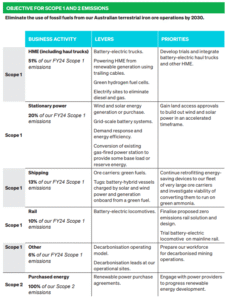
Industry Trends and the Bigger Picture
The mining industry is under pressure to reduce emissions. Investors, customers, and regulators all want cleaner operations. The International Energy Agency (IEA) reports that mining companies worldwide contribute 4–7% of total greenhouse gas emissions. This is mostly because they rely on fossil fuels for extraction and processing.
Green financing in the mining sector is becoming more common. BloombergNEF says global investments in energy transition hit over $1.7 trillion in 2024.
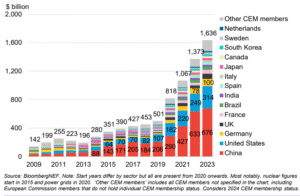
Mining projects are becoming a bigger part of this trend. Fortescue’s deal with China signals a deepening link between resource supply security and sustainable financing.
If Fortescue succeeds, it could set a standard for other resource giants. They will want to align with net-zero goals and stay profitable. It also highlights how the voluntary carbon market, renewable energy credits, and clean technology investments can converge in heavy industry.
Risks, Rewards, and the Road to Real Zero
Despite the funding boost, Fortescue faces significant challenges. Switching from diesel to electric and hydrogen machinery uses new technologies. These are unproven at this scale, so they may have reliability and cost problems. Building renewable energy in remote mining areas needs careful planning and permits.
Market risks are another factor. Global demand for iron ore depends on construction and manufacturing. Economic downturns can hurt the financial success of big decarbonization projects. Additionally, geopolitical tensions between Australia and China could create uncertainty for cross-border financing and trade.
If Fortescue achieves its 2030 targets, it could eliminate more than 3 million tons of CO₂e from its operations annually. This could be one of the first big mining companies to operate without fossil fuels. This change might lower the carbon intensity in the steel supply chain.
Fortescue’s $2 billion green loan is both a financial and strategic step forward. By getting funding from China, the company gains money for its decarbonization projects. It also strengthens its relationship with a key trading partner during the green transition era.
The next few years will test Fortescue’s ability to deploy large-scale renewable energy systems and shift its heavy equipment fleet away from fossil fuels. If the company meets its targets, it could serve as a model for how resource-intensive industries can transition toward net-zero while maintaining strong market positions.
The post Fortescue and China’s $2B Green Deal: Can the Australian Iron Ore Giant Go Fossil-Free? appeared first on Carbon Credits.
Carbon Footprint
Amazon Powers Ahead with Petronas’ Gentari Wind Energy Deal in India
Amazon Web Services (AWS) has signed a power purchase agreement (PPA) with Gentari for an 80-megawatt (MW) wind energy project in Tamil Nadu, India. This agreement is part of Amazon’s broader strategy to achieve net-zero carbon emissions by 2040 and supply its operations with 100% renewable energy.
Once operational in mid-2027, the wind farm could produce about 300,000 megawatt-hours (MWh) of electricity annually. This output can power many local operations and data center tasks. Plus, it helps reduce fossil fuel use.
The project also supports India’s renewable energy growth, which is essential to the country’s 2030 climate targets.
Strengthening Amazon’s Green Portfolio in India
The Gentari deal builds on AWS’s expanding renewable footprint in India. By mid-2025, Amazon had developed 50 large solar and wind projects. It also installed 44 rooftop solar systems at its facilities. Together, these projects represent more than 1.1 gigawatts (GW) of renewable capacity in the country.
This growing portfolio fuels Amazon’s offices, distribution centers, and data centers. It also helps the company aim to be the largest corporate buyer of renewable energy worldwide. The partnership with Gentari adds a strong wind element to its clean energy in India. It works well with the current solar capacity.
Why Wind Matters in AWS’s Net-Zero Game Plan
Amazon has committed to achieving net-zero carbon emissions by 2040, a decade ahead of the Paris Agreement’s target. The company is advancing by using renewable energy, improving energy efficiency, and making operational changes.

Key highlights include:
- Renewable Energy Leadership:
By 2024, Amazon had more than 500 renewable projects worldwide. Their total capacity was over 30 GW, enough to power millions of homes each year.
- 100% Renewable Energy Goal:
The company aims to match all electricity use with renewable energy by 2025, five years ahead of its original target.

- Electrification of Transportation:
Over 15,000 electric delivery vehicles are now operating globally, part of Amazon’s order for 100,000 EVs from Rivian.
- Emission Reductions:
Between 2021 and 2023, Amazon reported a 7% drop in carbon intensity, meaning emissions per dollar of sales decreased even as operations grew. In 2024, the tech giant emitted a total of over 68 million metric tons of CO2e.

- Carbon Removal Investments:
The company is backing nature-based and technological carbon removal projects, including reforestation and direct air capture.
These initiatives back Amazon’s Climate Pledge. Over 400 companies also signed it. The goal is to reach net zero by 2040.
SEE MORE on Amazon:
- Amazon’s $1 Billion Move Towards Net Zero: Logistics Electrification Across Europe
- Amazon Flies Greener to Net Zero with 9M Liters of Sustainable Fuel from Neste
- Amazon Expands Renewable Energy with 17 New Projects in Spain & First in Portugal
Gentari’s Tamil Nadu Hub: More Than Just a Breeze
Gentari, a clean energy subsidiary of Petronas, is positioning Tamil Nadu’s Karur region as a wind energy hub. The collaboration between Gentari and AWS extends beyond power supply.
In 2023, both companies signed a memorandum of understanding (MoU) to support fleet electrification in India. Gentari has helped deploy over 7,200 electric vehicles for last-mile delivery. This effort has helped Amazon reduce its transportation emissions as the tech giant moves toward net zero.
The partnership tackles two major sources of corporate carbon emissions: energy use and transportation. It does this by combining renewable energy projects with electrified logistics.
India’s Renewable Boom: A Global Leader in the Making
India’s renewable energy sector is growing rapidly. This growth is making the country a global leader in clean energy. In 2023–24, over 70% of new power generation came from renewable sources. This shows that the shift away from coal and fossil fuels is speeding up.
By early 2024, India had over 220 gigawatts (GW) of renewable energy. This total includes solar, wind, hydro, and biomass sources. Solar made up the largest share of recent growth, with over 21 GW of new capacity added in that year alone, followed by 3 GW of new wind projects.

Government targets remain ambitious. India’s National Electricity Plan aims for 500 GW of non-fossil fuel capacity by 2030. This supports its goal to meet 50% of electricity needs from renewable sources by then. This would require adding roughly 30–40 GW of new renewable capacity each year over the next six years.
Industry forecasts say that by 2030, renewable energy will account for about 35% of India’s power generation. This is an increase from around 21% in 2024.

This rapid growth comes from lower technology costs. In India, solar tariffs are very low, around ₹2–₹2.5 per kilowatt-hour (about $0.024–$0.03). State and central government incentives, such as the following, are helping to draw both domestic and foreign investment:
- accelerated depreciation benefits,
- production-linked incentives for solar manufacturing, and
- renewable purchase obligations for utilities.
The International Energy Agency (IEA) says India will likely be the third-largest market for new renewable capacity in the 2030s.
Corporate PPAs: The Hidden Engine of the Energy Transition
Corporate procurement has emerged as a powerful driver of India’s renewable energy expansion. Long-term power purchase agreements (PPAs), such as the AWS–Gentari deal, are popular for growing renewable projects. They offer steady revenue for developers and stable prices for buyers.
These agreements appeal to big energy users like data centers, factories, and logistics hubs. They need cost certainty and want to cut emissions to reach their environmental goals.
India has become a hotspot for corporate renewable energy adoption. BloombergNEF reports that in 2023, India’s corporate clean energy procurement topped 8 GW. This achievement ranks India as one of the top three countries for corporate renewable deals globally.
Top companies like Amazon, Microsoft, and Google, along with Indian giants Tata and Reliance, are signing multi-year PPAs. This helps them secure clean power.
For AWS, the benefits of this approach go beyond energy cost stability. Reaching its 100% renewable energy goal in India by 2025 helps fulfill its global Climate Pledge. This pledge aims for net-zero carbon emissions by 2040.
Opportunities and Obstacles on the Road to 2040
The AWS–Gentari deal shows how corporate partnerships can boost clean energy, but challenges still exist. Integrating variable renewable energy into India’s grid requires careful planning and investment in storage and transmission. Large-scale projects may also face land acquisition hurdles and permitting delays.
Even with these challenges, the outlook for renewable energy in India remains strong. AWS’s expanding presence in the country, along with key partnerships like this, shows how business needs can speed up the shift to a cleaner and stronger power sector.
AWS’s deal with Gentari for 80 MW of wind power in Tamil Nadu is more than buying renewable energy. It’s a smart investment in India’s clean energy system. By linking wind power generation with electric vehicle deployment, Amazon shows how corporate partnerships can deliver economic benefits and net zero progress in one of the world’s fastest-growing energy markets.
READ MORE:
- Amazon (AMZN) Stock Dips Despite Q2 2025 Beat: Cloud Growth Slows, Net-Zero Push Expands
- US Corporations Ramp Up Renewable Energy, Amazon Leads the Pack
The post Amazon Powers Ahead with Petronas’ Gentari Wind Energy Deal in India appeared first on Carbon Credits.
Carbon Footprint
Lithium Prices Jump as CATL Shuts Major Jianxiawo Mine in China
As per top media reports, China’s battery leader, Contemporary Amperex Technology Co. Ltd. (CATL), has stopped operations at a key lithium mine. This move surprised commodity markets and led to a rise in lithium prices. The shutdown occurred because of an expired mining license. It also comes as Beijing tightens control over excess capacity in the lithium sector.
CATL’s Major Lithium Hub Falls Silent
CATL’s mining license for the Jianxiawo lithium project in Yichun, Jiangxi, expired on August 9, 2025. Without approval to continue, the company closed the mine. CATL is now seeking a renewal. They aim to restart operations “as soon as possible.” However, experts believe the process may take at least three months due to current regulations.
Reuters highlighted that the Jianxiawo site, hailed as the “Lithium Capital of Asia,” produces over 46,000 metric tons of lithium carbonate equivalent (LCE) each year. This amount is about 3–6% of the world’s expected output for 2025. Even a short disruption at this key facility impacts global supply chains.
Beijing’s Crackdown on Overcapacity
This shutdown fits into Beijing’s broader efforts to control fast-growing industries. Officials target sectors with overcapacity, including steel, coal, and renewable materials. The lithium industry, which surged during the 2020–2022 price boom, is now under scrutiny.
Recently, authorities also ordered Zangge Mining in Qinghai province to halt production. CATL’s closure is the first major suspension in Yichun, showing that no company is safe from government actions.
Cost Pressures Threaten Viability
CATL’s cost structure shows the challenges miners face. Reports suggest production costs at Jianxiawo are around RMB 100,000 ($13,920) per ton, much higher than current market prices. This means the mine has been operating at a loss, which regulators may consider when reviewing its license renewal.
If Beijing aims to cut oversupply, delaying permits for high-cost operations like Jianxiawo could help stabilize prices.
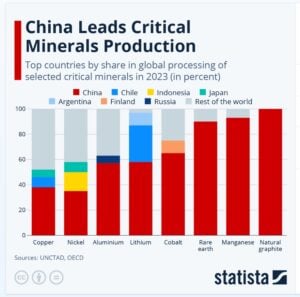
Lithium Stocks Surge on Supply Jitters
The market reacted quickly to CATL’s announcement. Lithium carbonate futures on the Guangzhou Futures Exchange jumped 8% to the daily limit. The shutdown led to a surge in lithium stocks, and shares of lithium miners worldwide rose sharply. Investors expected a tighter lithium supply and higher prices.
As per Bloomberg,
- In Hong Kong, Tianqi Lithium’s shares jumped 19% and China’s Ganfeng Lithium rose by 21%.
Australian miners also saw strong gains in a single day due to speculative buying. Even North American lithium producers, who faced heavy losses, gained renewed interest. For instance, Albemarle also benefited from rising investor optimism
Traders believed China’s supply cuts could benefit global competitors. Analysts say this rally shows both short-term speculation and hope for lithium price recovery from Beijing’s actions.
Regulatory Hurdles Ahead
Renewing a mining license in China involves multiple reviews. Environmental impact assessments, land use compliance checks, safety protocols, and community impact studies are all part of the process. Authorities also assess resource utilization efficiency to ensure sustainable operations.
Lithium is essential for electric vehicle (EV) batteries, especially lithium iron phosphate (LFP) types that dominate CATL’s production. With CATL holding a 37.9% share of the global EV battery market in the first half of 2025, any disruption to its lithium supply could lead to wider effects.
For CATL, the stakes are high. The Jianxiawo mine is crucial for its business model, supplying lithium for battery production and reducing reliance on imports. A prolonged shutdown may force the company to source more lithium abroad, increasing costs and complicating logistics.
Higher raw material costs, supply bottlenecks, and delivery delays may impact automakers relying on CATL’s batteries. Although the global market is oversupplied, local disruptions can still cause temporary price spikes and strain supply chains.
China’s Expanding Lithium Mining Power
Despite challenges, China’s lithium dominance is expected to grow. Fastmarkets predicts the country will surpass Australia as the world’s largest lithium producer by 2026, with 8,000–10,000 metric tons more output than its rival. This is a significant increase from 2023, when China ranked third after Australia and Chile.
However, many Chinese producers struggle with current prices, and government actions could reshape the industry. The goal seems to be a more efficient sector with stronger environmental compliance.
Market Outlook: Short-Term Lift, Long-Term Questions
Trading Economics highlighted that, in August, lithium carbonate prices climbed above CNY 75,000 per tonne, reaching their highest level since March.
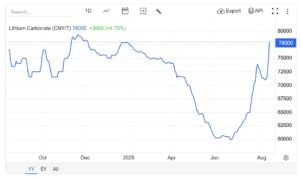
The post Lithium Prices Jump as CATL Shuts Major Jianxiawo Mine in China appeared first on Carbon Credits.
-
Climate Change2 years ago
Spanish-language misinformation on renewable energy spreads online, report shows
-
Climate Change Videos2 years ago
The toxic gas flares fuelling Nigeria’s climate change – BBC News
-

 Greenhouse Gases1 year ago
Greenhouse Gases1 year ago嘉宾来稿:满足中国增长的用电需求 光伏加储能“比新建煤电更实惠”
-

 Climate Change1 year ago
Climate Change1 year ago嘉宾来稿:满足中国增长的用电需求 光伏加储能“比新建煤电更实惠”
-

 Carbon Footprint1 year ago
Carbon Footprint1 year agoUS SEC’s Climate Disclosure Rules Spur Renewed Interest in Carbon Credits
-
Climate Change2 years ago
Why airlines are perfect targets for anti-greenwashing legal action
-
Climate Change Videos2 years ago
The toxic gas flares fuelling Nigeria’s climate change – BBC News
-
Climate Change2 years ago
Some firms unaware of England’s new single-use plastic ban





